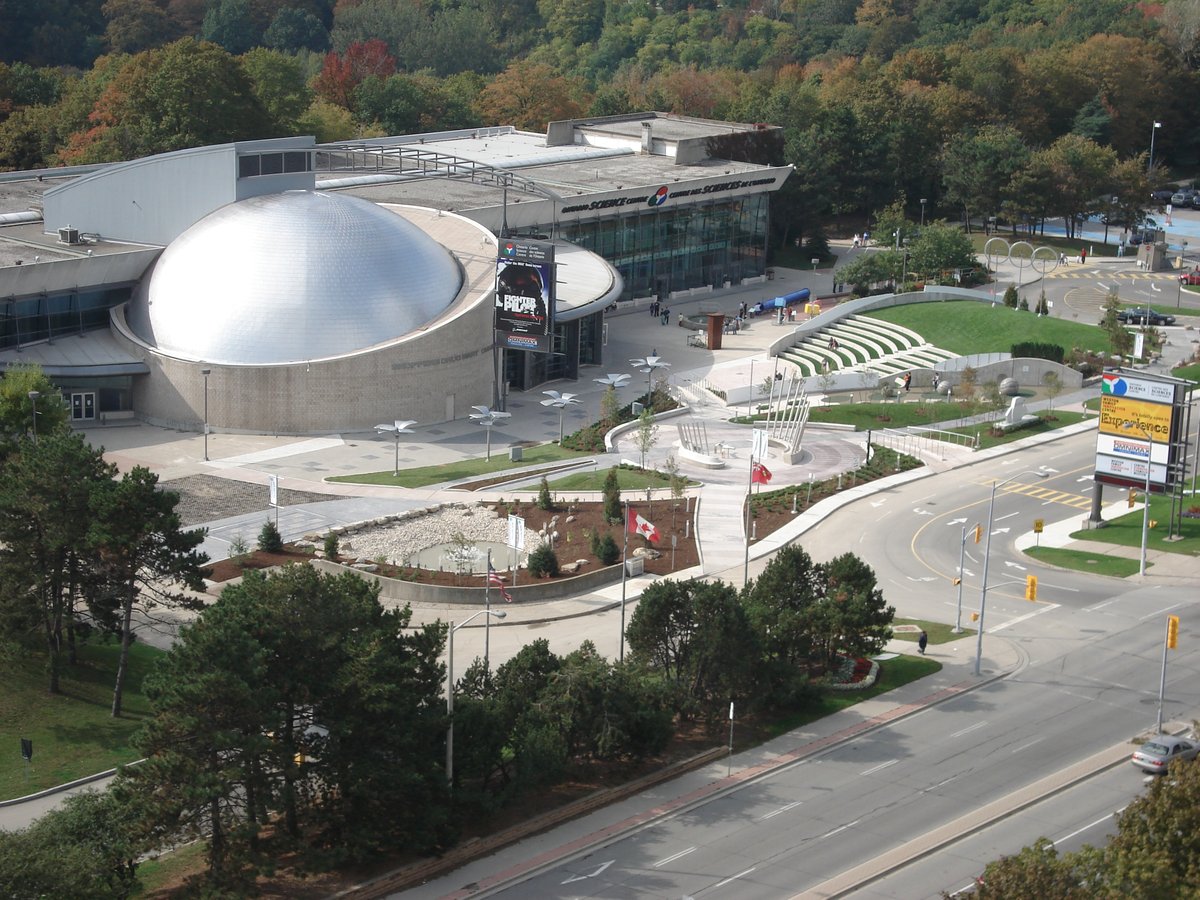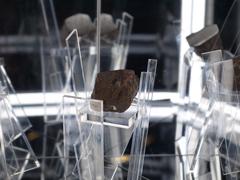
Ontario Science Centre Visiting Hours, Tickets, and Guide to Toronto Historical Sites
Date: 14/06/2025
Introduction
The Ontario Science Centre (OSC) has long been a cornerstone of scientific education and architectural innovation in Toronto. Established in 1969 as part of Canada’s centennial celebrations, the OSC pioneered hands-on, interactive exhibits, revolutionizing how science is experienced by visitors of all ages. Designed by Raymond Moriyama, the Centre’s integration with the Don River valley and its modernist-brutalist architecture have cemented its reputation as both an educational hub and a city landmark (Azure Magazine; Moriyama & Teshima Architects).
Today, as the original Don Mills location closes due to structural concerns, the OSC continues its mission through pop-up science events and digital programming, while preparing for an exciting new chapter at Ontario Place, expected to open in 2028. This guide covers everything you need to know about the OSC—its history, hours, tickets, accessibility, must-see exhibits, and travel tips—so you can make the most of your science adventure in Toronto. Always refer to the official Ontario Science Centre website for the most current information.
Table of Contents
- Introduction
- Origins and Historical Context
- Architectural Significance
- Visitor Information (Hours, Tickets, Accessibility)
- Must-See Exhibits and Experiences
- Cultural and Social Impact
- Recent Developments and Relocation
- Educational Programs and Community Engagement
- Directions and Transportation
- Visitor Tips and FAQs
- Conclusion and Resources
Origins and Historical Context
Centennial Project and Early Planning
The Ontario Science Centre, originally named the Centennial Centre of Science and Technology, was conceived in the early 1960s during a period of rapid urban growth in Toronto. It was envisioned as a flagship centennial project to foster a distinct Canadian identity through science and technology. Planning started in 1961, and by 1964, Ontario Premier John Robarts announced its creation, aligning with nationwide efforts to establish significant public institutions (Wikipedia; Kiddle; Azure Magazine).
Construction and Opening
Designed by Raymond Moriyama, the Centre’s construction began in 1966, with its doors opening in 1969. The location at 770 Don Mills Road was chosen for its dramatic ravine landscape, which became central to Moriyama’s architectural vision (Azure Magazine).
Pioneering Interactive Science Education
From its inception, the OSC broke from traditional museum models by focusing on interactive, hands-on exhibits. This approach made science accessible and engaging, influencing science museums worldwide (Azure Magazine).
Architectural Significance
Site-Specific Design
Moriyama designed the OSC to harmonize with the Don Valley’s natural contours. The campus features three interconnected buildings, bridges, and walkways that immerse visitors in both architecture and nature (Moriyama & Teshima Architects).
Modernist and Brutalist Influences
The OSC stands as an exemplar of modernist-brutalist architecture, characterized by exposed concrete, geometric forms, and expansive use of glass. Its monumental presence and forward-thinking design earned it the Ontario Association of Architects Landmark Designation Award (Azure Magazine).
Interior and Visitor Experience
The building’s layout fosters exploration through non-linear exhibit halls, ramps, and bridges, encouraging curiosity and discovery (Moriyama & Teshima Architects).
Expansion and Signature Features
Over the decades, the OSC expanded to include the OMNIMAX® Dome Theatre (1996), the Science Arcade, the Living Earth exhibit, and the Weston Family Innovation Centre, solidifying its place as a leader in science education (Wikipedia).
Visitor Information
Visiting Hours
- Current Status: The Don Mills facility is permanently closed as of June 2024. No regular visiting hours are available at this site.
- Pop-Up Locations: The OSC hosts temporary pop-up experiences at venues such as CF Sherway Gardens and Harbourfront Centre. Visiting hours vary by location and event. Always check the official website for up-to-date hours.
Tickets
- Pop-Up Admissions: Standard admission for pop-up events is typically $15 for adults and children (ages 3+); children under 2 are free at select sites.
- Special Programs: Additional fees may apply for specific exhibitions or workshops.
- How to Buy: Purchase tickets online or at the venue. Advance booking is recommended, especially for special events.
Accessibility
The OSC is committed to accessibility, offering:
- Wheelchair-accessible entrances and washrooms
- Elevators and ramps
- Sensory-friendly programs
- Assistive listening devices
- Trained staff to support visitors with diverse needs
For detailed accessibility information, consult the Parent Club Accessibility Guide.
Guided Tours and Events
- Guided tours and live science demonstrations are available at many pop-up locations.
- Special events and seasonal programs are scheduled throughout the year; check the OSC website for details.
Must-See Exhibits and Experiences
Innovation Station and Imagination Playground
Interactive spaces encourage creativity, teamwork, and open-ended play, ideal for families and groups (Ontario Science Centre).
Survival: The Exhibition and Earth Matters
Opening June 27, 2025, these new exhibitions offer immersive, hands-on experiences that explore survival skills and the interconnectedness of natural systems (Ontario Science Centre).
Living Earth
Explore a lush indoor rainforest with live animals and interactive biodiversity displays (Destination Toronto).
Space Hall and Planetarium
Features meteorites, space mission simulations, and astronomy exhibits for all ages (Destination Toronto).
OMNIMAX® Dome Theatre
Ontario’s only IMAX® Dome Theatre offers immersive science and nature documentaries (Ontario Science Centre).
Hydraulophone Fountain
The world’s largest outdoor hydraulophone invites visitors to play with water and sound (TourbyTransit).
Cultural and Social Impact
The OSC is a civic landmark and community hub, serving millions of visitors and hosting school programs, special events, and outreach initiatives (Ontario Science Centre 2022 Impact Report). Its commitment to inclusion is reflected in programs that embrace equity, diversity, and Indigenous perspectives (Ontario Science Centre EDI in STEM). The Centre is listed on Toronto’s Heritage Register, with ongoing advocacy for its preservation (Azure Magazine).
Recent Developments and Relocation
Why Did the Ontario Science Centre Close?
In June 2024, the Don Mills location was closed due to urgent structural safety concerns, notably the risk of roof collapse. Repair costs were prohibitive, and deferred maintenance had accumulated over years (Wikipedia). The closure impacted local communities and prompted immediate program relocations.
Relocation to Ontario Place
The OSC is moving to a new, state-of-the-art facility at Ontario Place, scheduled to open in 2028. The new centre will feature modern exhibits, expanded programming, and integration with other waterfront attractions (Ontario Science Centre Relocation).
Interim Options
Until the new facility opens, the OSC continues to offer:
- Pop-up science events across Toronto and Ontario
- Virtual programs for schools and families
- Outreach via community partnerships
Infrastructure Ontario is evaluating interim locations for future programming.
Educational Programs and Community Engagement
The OSC is a leader in hands-on science learning, offering:
- Curriculum-aligned workshops and teacher resources (Ontario Science Centre Teacher Resources)
- KidSpark STEM play areas for young learners (Destination Ontario KidSpark)
- Science festivals, special exhibits, and community outreach (Ride On Canada)
Directions and Transportation
- Pop-Up Locations: Easily accessible by TTC and other public transit. For example, CF Sherway Gardens is reachable by bus and Harbourfront Centre by streetcar.
- Ontario Place (Future): Will be accessible via transit, with parking and detailed directions to be announced closer to opening (Ontario Science Centre Relocation).
Visitor Tips and FAQs
Tips
- Check Locations: Always verify the current pop-up or event location and hours (official OSC website).
- Book Ahead: Purchase tickets in advance for popular exhibitions.
- Accessibility: Contact the OSC for specific accessibility requirements.
- Combine Visits: Explore nearby attractions like the Aga Khan Museum and Toronto Botanical Garden for a full day out.
Frequently Asked Questions
Q: What are the Ontario Science Centre’s current visiting hours?
A: The Don Mills building is closed. Pop-up event hours vary—see the official website.
Q: How can I buy tickets?
A: Tickets for pop-up events can be purchased online or onsite.
Q: Is the OSC accessible?
A: Yes. All pop-up locations and future facilities are designed for accessibility.
Q: Are guided tours available?
A: Yes, at many pop-up and special events. Check the schedule online.
Q: What other attractions are nearby?
A: Consider the Aga Khan Museum, Toronto Botanical Garden, and Ontario Place.
Conclusion
The Ontario Science Centre remains a vital part of Toronto’s educational and cultural landscape, even as it transitions to a new era. Through pop-up experiences, virtual programming, and an unwavering commitment to hands-on learning, the OSC continues to inspire curiosity and discovery. Stay informed on the latest developments, event schedules, and ticketing by following the official Ontario Science Centre website, subscribing to newsletters, and using the Audiala app for event notifications.
Resources and Official Links
- Ontario Science Centre Official Website
- Ontario Science Centre Relocation
- Destination Ontario
- TourbyTransit Ontario Science Centre Directions
- Ontario Science Centre 2022 Impact Report
- CBC Arts: Ontario Science Centre Cultural Significance
- Wikipedia: Ontario Science Centre
- Kiddle: Ontario Science Centre
- Ontario Science Centre EDI in STEM



























































































































































































